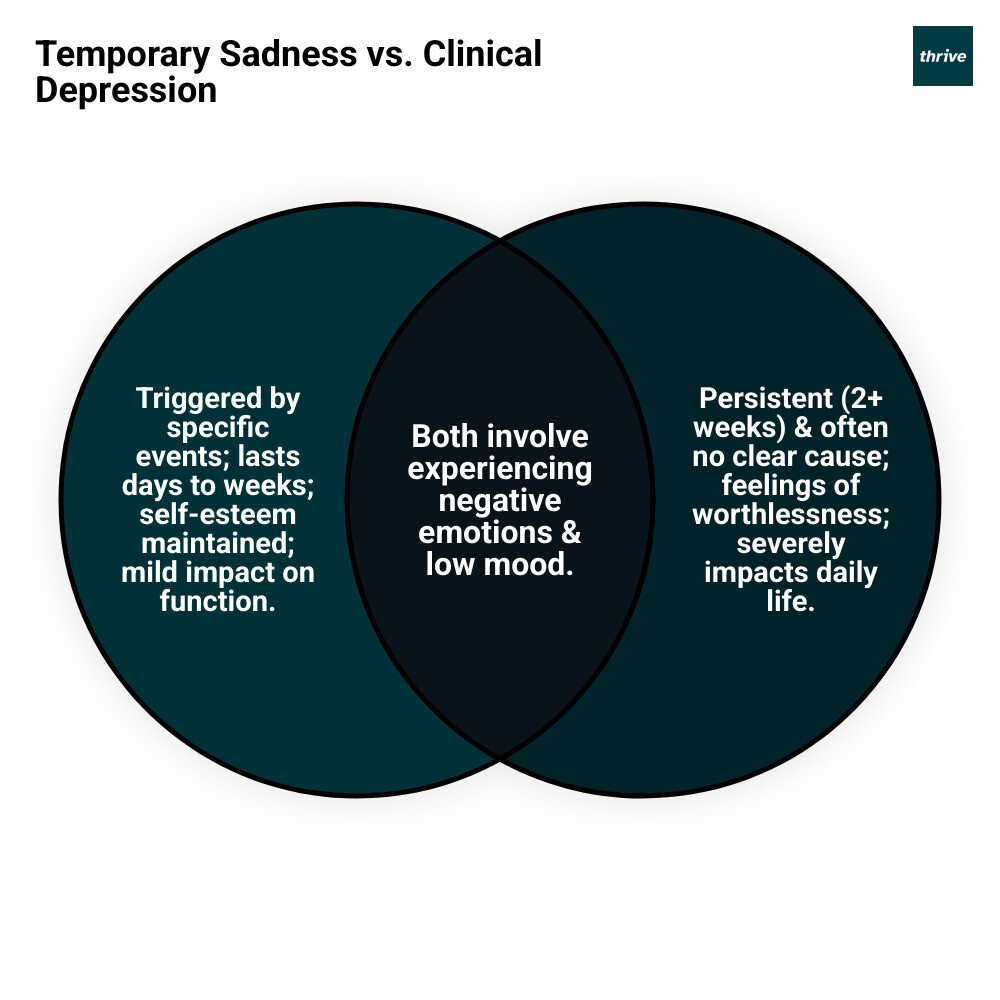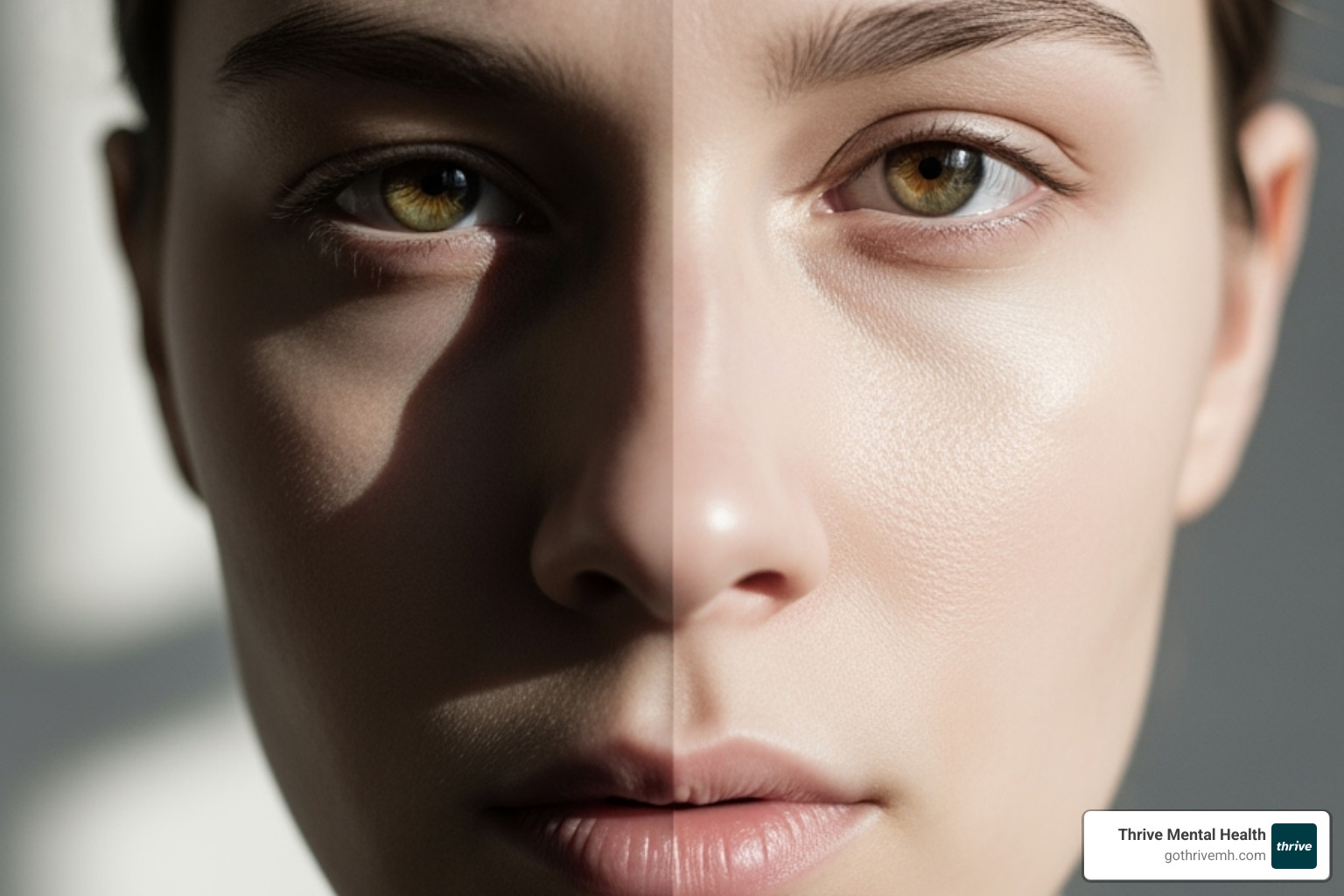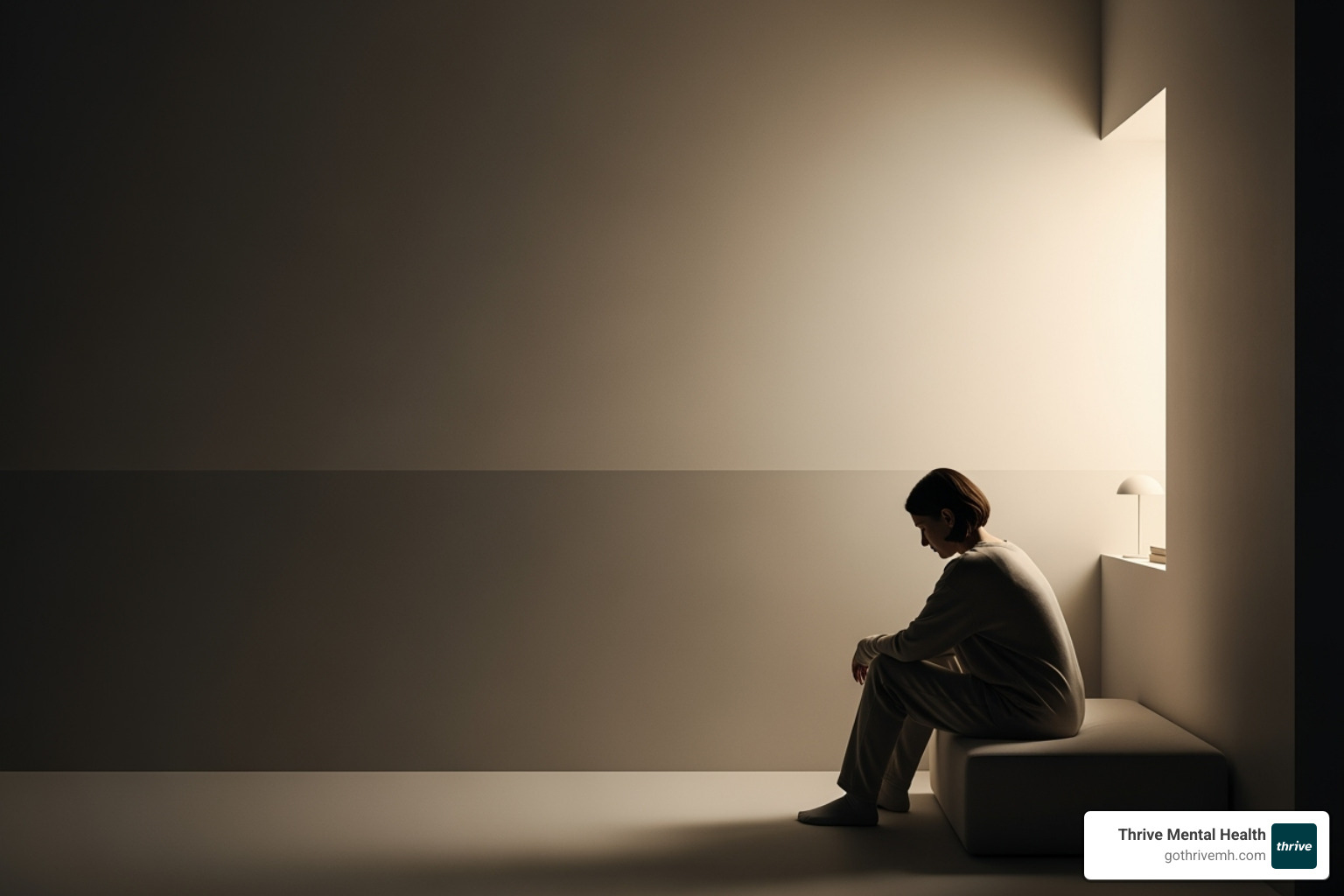What is Depression? Your Essential Guide to Symptoms, Causes, and Clarity

What Is Depression? [2025 Guide] Symptoms, Causes, and Fast Relief
Understanding What Depression Really Means
What is depression? It’s one of today’s most searched mental health questions. Affecting approximately 280 million people worldwide, depression is far more than just “feeling sad” or having a bad day.
It is a serious medical condition that causes persistent feelings of sadness, hopelessness, and a loss of interest in activities you once enjoyed. Unlike temporary sadness, depression can significantly impact your ability to function for weeks, months, or even years without proper treatment.
Here’s how depression differs from normal sadness:
| Temporary Sadness | Clinical Depression |
|---|---|
| Triggered by specific events | May occur without a clear cause |
| Lasts for days | Persists for 2+ weeks minimum |
| Mood fluctuates | Consistently low mood |
| Self-esteem remains intact | Involves feelings of worthlessness |
| Doesn’t significantly impair function | Severely impacts daily life |
The good news? Depression is highly treatable. Between 70-90% of people who seek treatment eventually respond well to care. Understanding what depression truly is becomes the first step toward getting better.
Recovery is possible, and you don’t have to go through it alone.
I’m Anna Green, LMHC, LPC, founder of Thrive Mental Health. I’ve spent years helping people overcome depression with evidence-based virtual care. My experience shows that with the right support, people can and do get better.

Recognizing the Signs: A Deep Dive into Depression Symptoms
Understanding what is depression means recognizing its complex web of symptoms, which touch our emotions, bodies, behaviors, and thoughts. These changes can develop gradually, but they create a pattern that significantly impacts daily life.

Depression doesn’t look the same for everyone. What appears as sadness in one person might be constant irritability in another. Understanding the full range of symptoms is key to recognizing it in ourselves and others.
Emotional Symptoms
The emotional core of depression is a persistent feeling of emptiness or hopelessness. A key sign is anhedonia—the loss of interest or pleasure in activities you once loved. Hobbies feel pointless and social gatherings exhausting. For many, especially men and teens, depression manifests as irritability and anger rather than sadness. Small frustrations can trigger major outbursts. Feelings of worthlessness and excessive guilt are also common, creating a harsh inner critic. It’s also important to note that anxiety and depression often coexist, with over 70% of people with depression also experiencing anxiety symptoms.
Physical Symptoms
Depression shows up in the body in tangible ways. Common physical symptoms include:
- Chronic fatigue that doesn’t improve with rest.
- Dramatic shifts in sleep patterns, such as insomnia or oversleeping.
- Appetite and weight changes, either a loss of appetite or increased comfort eating.
- Unexplained physical pain, like persistent headaches, stomachaches, or back pain.
- A significant decrease in sex drive.
Behavioral and Cognitive Changes
Depression noticeably alters our actions and thoughts. Social withdrawal is common, as people pull back from friends and family. Work or school performance suffers due to poor concentration and lack of motivation. Some people experience psychomotor changes, either moving more slowly or feeling restless and agitated.
Cognitively, depression creates a mental fog. Concentration and memory become difficult, and even simple decision-making can feel overwhelming. Thoughts often turn pessimistic, and in severe cases, may include thoughts of life not being worth living. If thoughts of death or suicide arise, this requires immediate professional attention.
Symptoms in Different Groups
Depression varies by age and gender.
- Gender: Women are diagnosed with depression more often, typically showing sadness and feelings of worthlessness. Men may exhibit anger, aggression, or risky behaviors like substance use. While women attempt suicide more often, men have a higher rate of suicide completion. More info about depression in women
- Teens: Symptoms can be mistaken for normal adolescent mood swings. Look for persistent irritability, declining grades, social withdrawal, and increased conflict.
- Children: Young children may not be able to articulate their feelings. They might complain of physical ailments like stomachaches, refuse to go to school, or seem constantly worried.
What is the difference between depression and sadness?
The line can feel blurry, but key differences exist. Sadness is typically a temporary reaction to a specific event. Depression, however, is a persistent illness. The main distinctions are:
- Duration: Sadness is temporary, while depression lasts at least two weeks.
- Impact: Sadness may slow you down, but depression can bring daily life to a halt, affecting work, relationships, and self-care.
- Self-Esteem: Sadness doesn’t usually attack your self-worth, whereas depression often involves intense feelings of worthlessness.
- Anhedonia: A complete loss of pleasure is a hallmark of depression, but rarely accompanies normal sadness.
If you’re questioning whether what you’re feeling is more than sadness, it’s a sign that speaking with a professional could be helpful.
Unpacking the “Why”: The Complex Causes and Risk Factors
What is depression in terms of its causes? It’s rarely one thing. Depression typically develops from a complex interplay of genetic, biological, and environmental factors.
Genetics and Family History
Family history plays a significant role. Having an immediate family member with depression can increase your risk by about 40%. Studies of identical twins show that if one has depression, the other has a 70% chance of developing it too. However, genetics are about vulnerability, not destiny. Many with a family history never develop depression, while others with no history do.
Brain Chemistry and Structure
Depression involves changes in brain chemistry, particularly with neurotransmitters like serotonin, norepinephrine, and dopamine, which regulate mood, energy, and sleep. Brain imaging studies also show structural and functional differences in brain regions responsible for mood regulation in people with depression. The relationship is complex, involving not just chemical levels but how the brain responds to them.
Hormonal Changes
Hormones are powerful mood regulators. Fluctuations during menstrual cycles, pregnancy, the postpartum period, and menopause can trigger or worsen depression in women. Thyroid disorders, such as hypothyroidism, can also produce symptoms that mimic depression.
Chronic Illness and Pain
Living with a chronic health condition creates physical and emotional stress that increases depression risk. The link is bidirectional: illness can lead to depression, and depression can worsen physical health. People with heart disease, cancer, and diabetes are at higher risk. The connection with chronic pain is especially strong, with up to 85% of chronic pain patients also experiencing depression. Scientific research on chronic pain and depression highlights this deep connection.
Stressful Life Events
Major life events can trigger depression, especially in vulnerable individuals. These can include loss and grief, financial hardship, or significant workplace stress. Even positive but stressful events like marriage or a new job can sometimes act as a trigger.
Childhood Trauma
Adverse childhood experiences (ACEs)—such as abuse, neglect, or household dysfunction—significantly increase the risk of depression in adulthood. These early traumas can alter brain development and stress response systems, creating long-term vulnerabilities.
Substance Use
The relationship between substance use and depression is a vicious cycle. People may use alcohol or drugs to self-medicate, but these substances ultimately disrupt brain chemistry and worsen depression. About 21% of people with a substance use disorder also have depression, making it crucial to address both conditions during treatment.
From Diagnosis to Different Forms: What is Depression Clinically?
Getting a clinical answer to what is depression requires a thorough evaluation by a healthcare professional. There’s no single blood test or scan; instead, diagnosis is a process of gathering clues.
Diagnostic Process
A professional diagnosis typically involves:
- A detailed conversation about your symptoms, their duration, and their impact on your life.
- A review of your personal and medical history to identify contributing factors. Your provider will likely perform a physical exam and order blood tests to rule out medical conditions like thyroid problems or vitamin deficiencies that can mimic depression.
- Using diagnostic criteria from the DSM-5 (Diagnostic and Statistical Manual of Mental Disorders, Fifth Edition). For Major Depressive Disorder, this means having at least five specific symptoms for two weeks or more, including either a depressed mood or loss of interest/pleasure.
Screening tools like the PHQ-9 questionnaire can help measure symptom severity, but they are just one part of a comprehensive evaluation. An accurate diagnosis is the roadmap to effective treatment.
What is the clinical definition of depression?
Clinically, “depression” refers to several distinct mood disorders:
- Major Depressive Disorder (MDD): This is the classic form of depression, characterized by episodes of intense sadness, hopelessness, and other symptoms lasting at least two weeks.
- Persistent Depressive Disorder (Dysthymia): A chronic, lower-grade depression lasting for at least two years. The symptoms are less severe than MDD but are long-lasting.
- Postpartum Depression (PPD): Occurring during pregnancy or after childbirth, PPD involves intense sadness, anxiety, and difficulty bonding with the baby, going far beyond the “baby blues.”
- Seasonal Affective Disorder (SAD): A pattern of depression that occurs during the fall and winter months when there is less natural sunlight. Symptoms typically improve in the spring.
- Bipolar Disorder: Involves episodes of depression that alternate with periods of mania or hypomania (liftd mood). It requires a different treatment approach than other forms of depression.
- Psychotic Depression: A severe form of depression that includes psychosis, such as hallucinations or delusions. This condition requires immediate, specialized care.
Understanding these different forms is crucial, as each requires a custom treatment plan.
Finding Your Path Forward: Evidence-Based Treatment Options
If you’re in crisis or having thoughts of suicide, call or text 988 right now to reach the 988 Suicide & Crisis Lifeline. You are not alone.
The most encouraging news about what is depression is that it’s highly treatable. With the right support, recovery isn’t just possible—it’s probable.
Psychotherapy (Talk Therapy)
Therapy helps you understand the thoughts, feelings, and behaviors that fuel depression.
- Cognitive Behavioral Therapy (CBT) helps you identify and challenge negative thought patterns to develop more balanced perspectives.
- Dialectical Behavior Therapy (DBT) is especially useful for overwhelming emotions, teaching skills in mindfulness, emotional regulation, distress tolerance, and interpersonal effectiveness.
- Psychodynamic Therapy explores how past experiences shape your present, offering insight into the roots of your emotional patterns.
At Thrive, our programs integrate these approaches. Learn more about our IOP Programs and PHP Programs. Prefer to meet from home? Explore our Virtual Therapy and hybrid options.
Medications (Antidepressants)
Antidepressants are not “happy pills”; they help restore balance to brain chemistry, making it easier to engage in therapy and daily life. They typically take 2-4 weeks to work, and finding the right one may require some adjustment.
- SSRIs (Selective Serotonin Reuptake Inhibitors) are a common first-line treatment that increases available serotonin.
- SNRIs (Serotonin and Norepinephrine Reuptake Inhibitors) affect both mood and energy levels.
- Atypical antidepressants work through different mechanisms and may be used when other medications are ineffective.
Brain Stimulation Therapies
For severe or treatment-resistant depression, these can be life-changing.
- ECT (Electroconvulsive Therapy) is a highly effective procedure performed under anesthesia for severe depression.
- TMS (Transcranial Magnetic Stimulation) is a non-invasive option that uses magnetic fields to stimulate underactive brain regions involved in mood.
Building a Supportive Lifestyle
Professional treatment is most effective when paired with lifestyle changes.
- Exercise: Even a daily 20-minute walk can boost mood-regulating brain chemicals.
- Sleep Hygiene: Consistent sleep schedules and a calming bedtime routine are crucial, as poor sleep worsens depression.
- Mindfulness and Meditation: These practices can help you respond to difficult thoughts and emotions more effectively.
- Support System: Connection combats the isolation that feeds depression. Surround yourself with trusted friends, family, or support groups.
Insurance and Access to Care
Thrive Mental Health offers flexible virtual and in-person care options designed for professionals in Florida. We work with major insurance providers like Cigna, Optum, and Florida Blue to make treatment affordable. Our team handles the insurance verification process so you can focus on recovery. Read more about navigating insurance for mental health care. Want to see your coverage now? Verify insurance in 2 minutes.
The Risks of Waiting: Complications of Untreated Depression
Disclaimer: This section discusses suicide. If you or someone you know is in crisis, please call or text 988 to connect with the 988 Suicide & Crisis Lifeline.
Asking what is depression must include understanding the risks of leaving it untreated. Depression rarely stays contained; it can impact every area of life.

Unlike a minor injury that heals with time, depression tends to deepen when ignored. The consequences can be serious:
- Worsening Mental Health: Untreated depression increases the risk of developing other conditions, like anxiety disorders, creating a double burden that is harder to manage.
- Increased Risk of Substance Use: Many turn to alcohol or drugs for temporary relief, but this self-medication ultimately worsens depression and can lead to addiction.
- Relationship Problems: Irritability, withdrawal, and fatigue strain relationships with partners, family, and friends, leading to isolation that fuels the depression.
- Work and School Issues: Difficulty concentrating and lack of motivation can lead to poor performance, job loss, or academic failure. Teens with depression are twice as likely to drop out of high school.
- Physical Health Problems: Depression increases the risk of cardiovascular disease by 40% and can worsen conditions like diabetes and chronic pain.
- Increased Risk of Suicide: The most serious risk of untreated depression is suicide. Depression is a major risk factor for suicidal thoughts and behaviors.
These risks are preventable. Depression is highly treatable, with 70-90% of people responding well to care. At Thrive Mental Health, we’ve seen countless individuals reclaim their lives through our virtual IOP and PHP programs. The question isn’t whether you can afford to get help—it’s whether you can afford not to.
Frequently Asked Questions about Depression
When people search “what is depression,” they often have specific questions about recovery and getting help. Here are straightforward answers to the most common concerns.
Can depression be cured completely?
Depression is highly treatable, and many people achieve full remission, meaning their symptoms go away completely. For some, it’s a single episode they overcome. For others, it’s a chronic condition managed with ongoing care, similar to diabetes. Between 80-90% of people respond well to treatment, allowing them to live full, meaningful lives.
How do I know if I have depression or am just sad?
The key differences are duration, intensity, and impact. Normal sadness is a temporary response to a specific event. Clinical depression is a persistent illness lasting at least two weeks that significantly disrupts your ability to function. The clearest signs that it’s more than sadness are anhedonia (loss of pleasure in everything), feelings of worthlessness, and major changes in sleep or appetite.
What is the first step to getting help for depression?
Taking the first step is a sign of strength. Start by talking to someone you trust, like your primary care doctor. A doctor can rule out any medical conditions causing your symptoms and refer you to a mental health specialist. You don’t have to have it all figured out; the most important thing is to reach out.
Ready for support? Thrive offers virtual and hybrid IOP/PHP with evening options. Verify your insurance in 2 minutes (no obligation) → Start benefits check. If you’re in crisis, call/text 988.
How long do antidepressants take to work?
Most people start noticing improvements in sleep and energy within 1-2 weeks, with full mood benefits often taking 4-6 weeks. Stay in close contact with your prescriber to adjust as needed.
Is virtual IOP as effective as in-person care?
For many, yes. Virtual IOP delivers structured, evidence-based therapy with the flexibility to attend from home—especially helpful for busy professionals. Explore our IOP Programs and PHP Programs to see what fits.
{
"@context": "https://schema.org",
"@type": "FAQPage",
"mainEntity": [
{
"@type": "Question",
"name": "Can depression be cured completely?",
"acceptedAnswer": {
"@type": "Answer",
"text": "Depression is highly treatable and many people achieve full remission. Others manage it long term with therapy, medication, and lifestyle changes."
}
},
{
"@type": "Question",
"name": "How do I know if I have depression or am just sad?",
"acceptedAnswer": {
"@type": "Answer",
"text": "Depression lasts at least two weeks and impairs daily functioning. Key signs include anhedonia, feelings of worthlessness, and major sleep or appetite changes."
}
},
{
"@type": "Question",
"name": "What is the first step to getting help for depression?",
"acceptedAnswer": {
"@type": "Answer",
"text": "Talk to a primary care doctor or a mental health professional. They can rule out medical causes and connect you with effective treatment options."
}
},
{
"@type": "Question",
"name": "How long do antidepressants take to work?",
"acceptedAnswer": {
"@type": "Answer",
"text": "Sleep and energy often improve within 1–2 weeks; full mood benefits may take 4–6 weeks."
}
},
{
"@type": "Question",
"name": "Is virtual IOP as effective as in-person care?",
"acceptedAnswer": {
"@type": "Answer",
"text": "For many people, virtual IOP is as effective as in-person care, providing structured, evidence-based therapy with greater flexibility."
}
}
]
}
Ready for support? Thrive offers virtual and hybrid IOP/PHP with evening options. Verify your insurance in 2 minutes (no obligation) → Start benefits check or call 561-203-6085. If you’re in crisis, call/text 988.